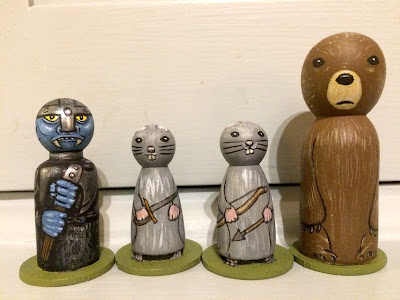Hordes of the Things is the best mass-battle fantasy ruleset around, I reckon. It's quick to set up, quick to play and brimming with tactical depth. And it copes with any vaguely fantastical period - hence my current 40K HotT project (designed both to use up spare miniatures and to introduce 40K-attuned friends to the glories of HotT).
Standard HotT games use 24AP armies and strict victory conditions. But we often play much bigger games: 36 or more AP a side. We also tend to play to the death or surrender rather than achieving 'technical' victories (as when a general is destroyed as the first casualty of the game). Those are fine for tournaments, but the game's mechanic for the loss of a general (troops become twice as hard to manoeuvre) is a perfectly good penalty if you just play on.
So the game's certainly good for a bit of stretching beyond its usual rigid parameters. Last week, my son and I decided to stretch it a bit more by playing it with individually based miniatures rather than the usual 'elements' of three or four figures.
We used 28mm infantry figures based on 25mm squares and cavalry based on 25mm x 50mm. So all frontages were 25mm, as opposed to the usual HotT practice of 40mm for 10 or 15mm and 60mm for 25mm or 28mm. Each individual miniature counted as a full element, and we used a 3' x 3' table (the 28mm standard) with 15mm movement rates. We also started with 54AP armies - huge by HotT standards - but kept the PIPs (activation points) roll at a single d6.
 |
| Orc warbands and spears await goblin riders and reptilian behemoths. The smaller cold one on its own was classed as a knight element. |
So how did it go? Well, it was great. My son said that he preferred it to normal HotT (and he's an enthusiast). The larger table, relative to both bases and movement ranges, opened up a lot of space for manoeuvre. And the standardised base depths caused no problems. They theoretically entail very slight advantages for pursuing troops, as those would end up aligned again after pushing back or destroying elements that would usually have different base depths. But that's a trivial consideration. And all HotT base depths are "suggested minima" in any case, so this is still "rules as written".
The only other disadvantage I could see was that square, single-figure elements can look a little odd when one element is providing rear support to another (as with spears and warbands). Having figures standing in columns of two men isn't as convincing as having two rectangular elements backing each other up. It's a very minor point, though.
Other than that, I thought this version of the game offered several advantages:
1. It's a rank-and-flank game for individual figures that's much quicker to play than most of the alternatives (Warhammer, for example).
2. Huge battles are possible. 100 AP a side looks eminently doable. But 24AP games will work just fine too.
3. The single-figure basing keeps everything in scale. One of the few drawbacks of HotT is that certain elements can look oddly over- or underpowered on the table. This tends to apply particularly to behemoths. One player's behemoth might be a solitary, underfed-looking troll while another's might be some huge monster that takes up almost all of the available base space. In this game, we used GW cold-one riders as behemoths, and they looked just right: bigger and meaner than a knight, and dangerous to be near, but not oversized for their fighting ability. Similarly, dragons that fit on 25 x 50mm bases will tend to be appropriately sized, and the same goes for gods and heroes. Airboats might be a challenge, I admit - but then, they always are. Huge plastic vehicles could be supported on perspex rod and heavily weighted 25 x 50 bases, though.
4. Creating elements through painting up a single figure is an attractive option. Need a sneaker? That goblin looks suitably crafty. A flyer? Let's give the magician general an imp familiar. And so on. We found it remarkable easy to parse a batch of orcs into various battlefield roles: spears, warbands, shooters, blades, hordes, heroes, etc.
5. Using the same miniatures for different purposes. I have lots of square-based orcs because the EM4 ones come with square bases that are a paint to remove, and so I based matching Nick Lund metal figures similarly. I've used them for Saga in the past and intend to use them in Of Gods and Mortals, in which square bases are useful. This version of HotT gets still more use out of them.
All in all, I'd say that it's a good way to get a bit more out of both a common basing type and the excellent HotT rules.
 |
| Warbands drive through wolfriders |












